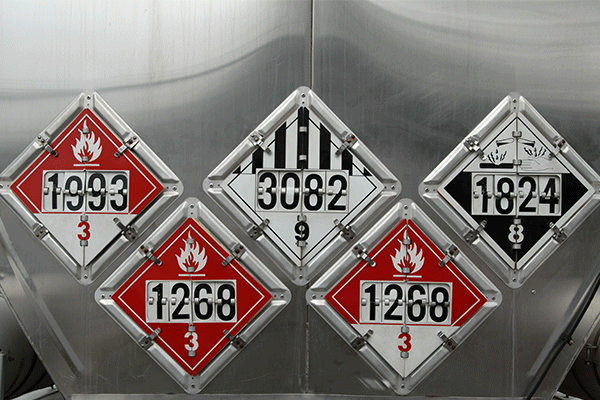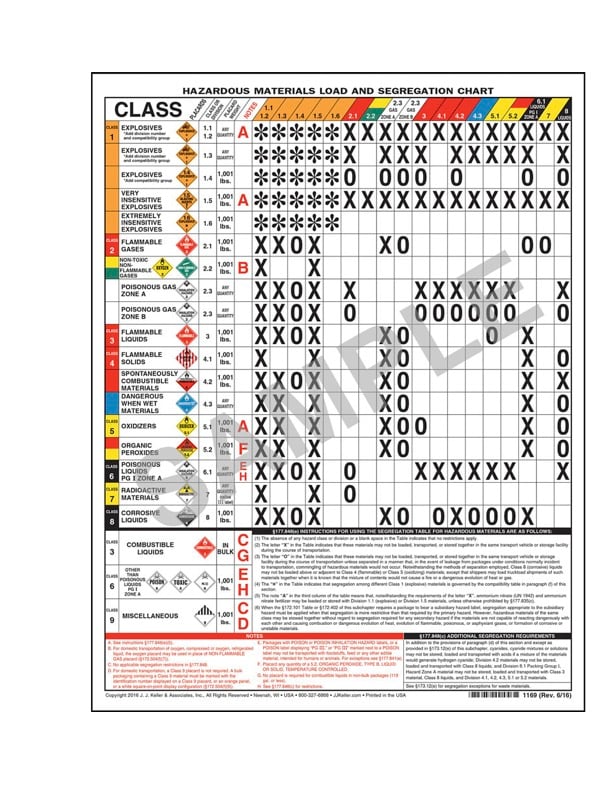Shipping hazardous freight requires attention to detail and strict adherence to regulations. Whether you're transporting chemicals, flammable materials or other dangerous goods, complying with legal and safety requirements is the only way to keep the roads and the public safe.
Over 68 years of shipping hazardous materials, Anderson Trucking Service (ATS) has learned the importance of sticking to the rules. Our staff consistently focuses on safely handling and transporting hazardous materials.
In this article, you will learn the standards in place for hazardous shipping, how to comply with them and other factors to consider when shipping hazardous freight.
For your convenience, we’ve separated this information into the following buckets:
- Hazmat freight shipping requirements
- How hazmat carriers use classifications
- Requirements for labeling hazmat freight
- Shipping hazardous tanker freight
- Shipping and handling hazardous liquid freight
- Who is responsible for specifying the hazardous level of the freight?
Hazmat Freight Shipping Requirements
Hazardous (hazmat) materials are any substance that may pose a risk to health, property and/or the environment.
Many of these substances are used on a daily basis: cleaning chemicals, pesticides, fertilizers and gasoline. They are needed nationwide, although some geographic areas are more popular for hazardous freight. Because of the potential danger they pose, these products need special care during transit.
Drivers who haul hazmat freight must have a hazmat endorsement, noted by an H on their CDL. This certification shows that the driver has passed a background check and regularly completes education and testing on handling and securing hazardous materials, as well as how to react when something goes wrong.
It’s not just the driver who needs hazmat certification. Carriers also need a hazmat certificate registered with the Department of Transportation.
When specifying your shipment, ask about the safety and compliance program. If your broker or carrier does not have a program for moving hazmat freight, consider if this is the right shipping partner for you. You can’t take chances when health and safety are at stake.
After you have verified that the driver and carrier can carry hazardous materials, work together to plan the specifics of your shipment.
How Hazmat Freight Carriers Use Classifications
There are nine hazardous material classes:
- Class 1: Explosives
- Class 2: Gasses
- Class 3: Flammable Liquid and Combustible Liquid
- Class 4: Flammable Solid, Spontaneously Combustible and Dangerous When Wet
- Class 5: Oxidizer and Organic Peroxide
- Class 6: Poison and Poison Inhalation Hazard
- Class 7: Radioactive
- Class 8: Corrosive
- Class 9: Miscellaneous/General Danger

Each of these nine classes is divided into sub-classes that further define the safety requirements for the material. The carrier and driver need to know the classification and sub-classification for everything in the shipment to determine how the load must be secured and handled.
What Is the Hazmat Segregation Table?
Some hazardous materials become reactive when combined with another substance. While safety is always the driver’s top priority, sometimes accidents or unanticipated things happen on the road — and mixing hazards could have disastrous results.
 To prevent dangerous combinations, the hazmat segregation table lists all categories of hazardous materials and indicates the level of danger they pose when combined.
To prevent dangerous combinations, the hazmat segregation table lists all categories of hazardous materials and indicates the level of danger they pose when combined.
There are two classifications on the chart that require special consideration during transit.
- Two materials that may not be loaded, transported or stored together in the same transport vehicle or storage facility during the course of transportation. These cannot be in the same truck.
- Materials that may not be loaded, transported or stored together unless they are separated in a way that commingling can not occur. These could be in the same truck as long as they are in sturdy, leakproof containers.
It is vital that your carrier understands the table and uses it when preparing for shipment. The result of combining non-compatible materials on a shipment could be disastrous.
Requirements for Labeling Hazmat Freight
Hazmat freight must be labeled with a hazard sticker indicating the classification, as well as the four-digit United Nations (UN) Globally Harmonized Classification code. Labels must be on all four sides of the freight container and the outside of the vehicle.
All hazmat freight also requires a completed Safety Data Sheet (SDS). Information on the SDS includes:
- Hazardous ingredients
- Hazardous characteristics
- Potential effect on health and environment
- Chemicals and materials that can cause adverse reactions
- Handling precautions
- Instructions to control exposure and contain spills
- First aid instructions.
When necessary, the SDS should be provided along with the Bill of Lading and other paperwork.
Once the shipment is properly labeled, transit can begin.
Shipping Hazardous Tanker Freight
According to a 2011 mandate by the Federal Motor Carrier Safety Administration (FMCSA) “tanks” are:
- Any commercial vehicle that’s designed to transport liquid or gas within one or more tanks that have an individual capacity of more than 118 gallons each.
- 1,000 gallons or more of liquid or gas that is attached to the commercial motor vehicle in transit.
Tanker freight requires special handling because of the tendency of the liquid to slosh back and forth within the container. This shifting can cause the weight of the truck to shift, and the driver has to take special care to account for the shifting weight.
More information about shipping tanker freight, read What is a Tanker Endorsement?
Shipping and Handling Hazardous Liquid Freight
Some freight is classified as both a liquid and a hazard (think liquid fertilizers). Hauling hazardous liquid freight combines the hazards of hauling tanker freight PLUS the dangers of hauling hazmat freight.
Hazardous liquid freight can be carried in a tanker truck, or it can be hauled in a dry van or flatbed truck using intermediate bulk container (IBC) totes.
The tank used to haul the hazardous liquid freight must be leakproof to protect the other goods in the truck as well as public health and safety.
The driver and shipper should also take care to make sure there is no residue inside or outside the container. This residue may be a reactive substance or a substance that will damage the container.
Drivers hauling hazardous liquid freight must have an X endorsement on their CDL. Only this certification indicates that the driver understands the hazards of both liquid and hazardous freight.
If you are shipping any freight that requires driver endorsement, it’s critical to specify that early in the process. If the driver arrives and isn’t licensed for your shipment, you will be charged for the downtime while your carrier finds a qualified replacement.
In trucking, being specific and thorough is always critical. This is especially true when sourcing a load of hazardous freight.
Who Is Responsible for Specifying the Hazard Level of the Freight?
The shipper is ultimately responsible for specifying the type and classification of freight.
The carrier and driver are responsible for moving the cargo as specified. If the specification is inaccurate, the shipper is responsible for the inaccuracy. If any harm or danger occurs because of the wrong specification, you may be found liable.
When specifying a load of hazardous freight, include information for at least one point of contact in addition to the SDS. Keeping an open line of communication with the carrier can help avoid any problems or questions during transit.
Ensuring the accuracy of the specification starts with a thorough SDS. Before finalizing any shipment, be sure you have all the necessary information and have shared that with your provider.
Work Together to Safely Ship Hazardous Materials
Properly securing and transporting hazardous materials is the only way to keep the freight, driver, environment and public free from the dangers posed by hazardous materials. Rather than taking any risks, it’s important for the shipper, the driver and the broker or carrier to work together.
- The shipper specifies the type of freight and how it will be packed for transport.
- The broker or carrier implements a strict oversight program to verify that all elements of safe shipping are in place.
- The driver maintains proper hazmat shipping credentials and takes appropriate caution with everything in the load.
When everyone plays their part, people, property and the freight itself will be protected from the potential hazards inherent in shipping hazardous materials.
For more details about shipping hazardous materials, read the Ultimate Guide to Hazmat Freight Shipping. If you’re ready to get started, contact ATS for more information about our safety and compliance program.





